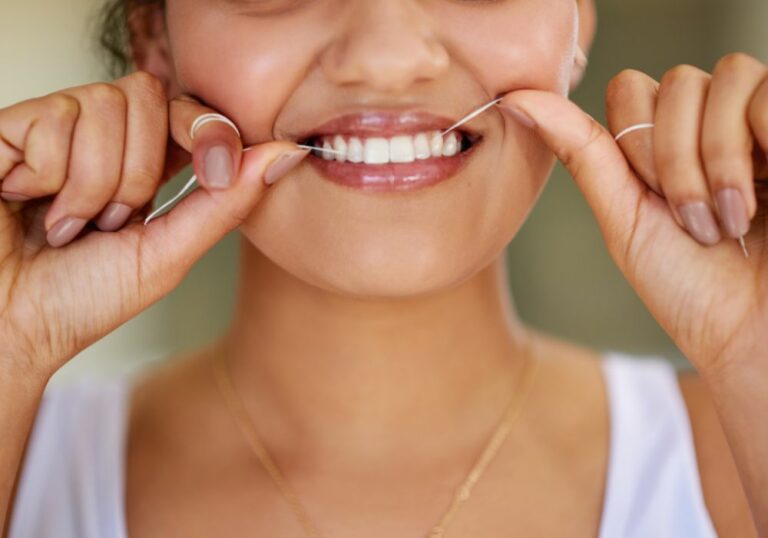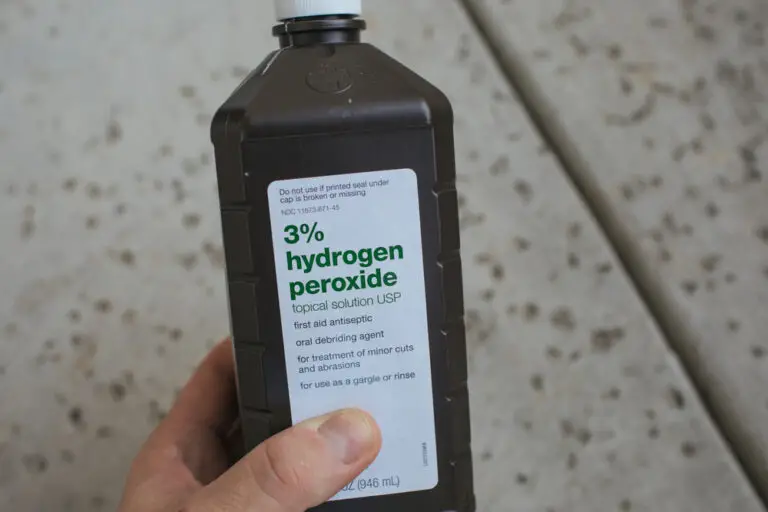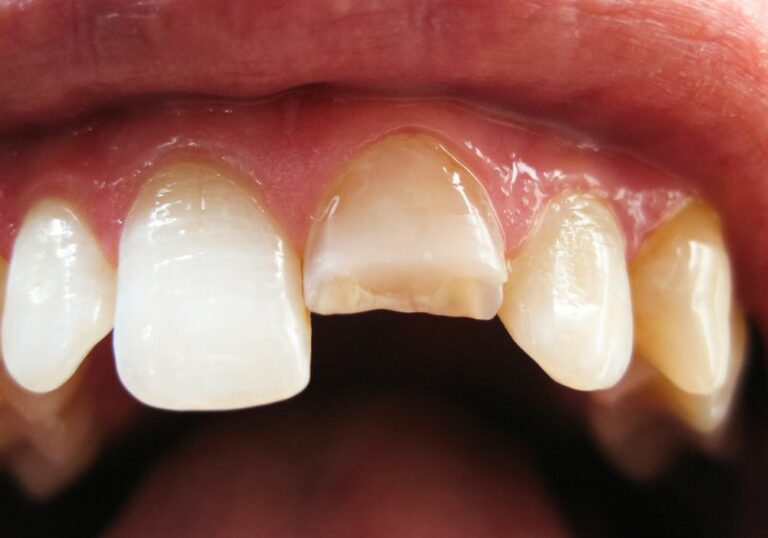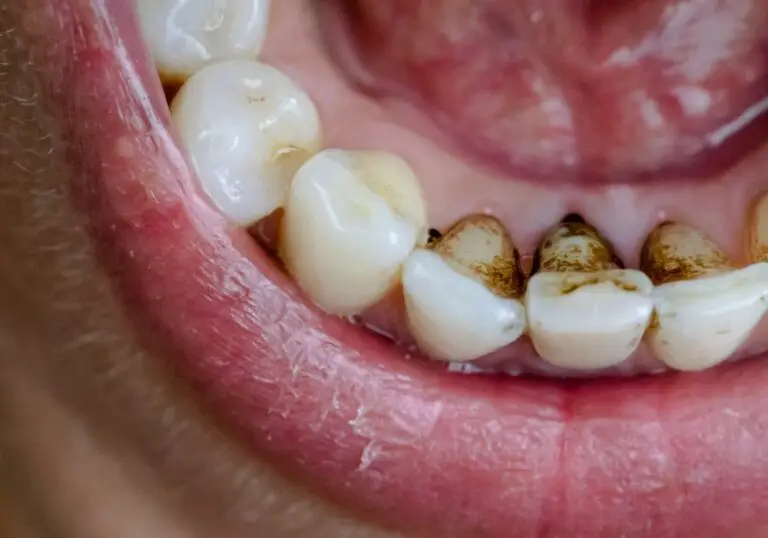Smoking is a dangerous habit that can lead to many health problems, including issues with oral health. While most people are aware of smoking’s links to lung cancer and heart disease, the effects on the teeth and gums may be less widely known. This article explores the question: can smoking too much make your teeth hurt? We’ll examine in depth the scientific evidence showing how smoking severely impacts oral health and the mechanisms by which it can cause toothaches, gum pain and other dental pain.
How Smoking Affects Oral Health
Smoking has several deleterious effects on oral health:
Increased risk of periodontal disease
Periodontal (gum) disease is an inflammatory condition affecting the tissues surrounding and supporting the teeth. It’s caused by a buildup of plaque, a sticky film of bacteria. Smoking is a major risk factor for gum disease as it affects the body’s immune response and healing capabilities in multiple ways:
- It reduces blood flow to the gums, restricting delivery of oxygen and nutrients needed for healthy gum tissue. This makes the gums more susceptible to bacterial infection.
- It interferes with production of antibodies that fight infection in the gums. Smokers have fewer antibodies than non-smokers.
- It impairs the function of gingival fibroblasts which help keep periodontal tissue robust. This weakens the attachment of gums to teeth.
- It limits nutrients reaching the bone supporting the teeth. Over time, this can cause bone loss and increased tooth looseness.
- It diminishes the outcomes of periodontal treatment. Smokers don’t respond as well to deep cleanings and bone grafting.
The sum of these detrimental vascular and immunologic effects is that smokers have more plaque and tartar buildup, increased gum recession, deeper periodontal pockets, greater loss of supporting bone, and more advanced gum disease than non-smokers.
Higher rates of tooth decay
The carcinogens and nicotine in tobacco smoke lower saliva production and alter its chemical composition in ways that promote decay:
- It makes saliva more acidic. The pH drops from a normal neutral 6-7 down to acidic 5.5. This corrodes and demineralizes the tooth enamel over time.
- It reduces mineralizing components in saliva like calcium, phosphate and fluoride that strengthen enamel.
- It decreases salivary buffers that neutralize plaque acids.
- It lowers salivary proteins like immunoglobulin A which combat bacteria and viruses.
With less saliva and reduced anticariogenic functions, the mouth is less able to counter plaque acids which demineralize and decay the teeth. Sticky tobacco tar also adheres to teeth, providing an environment for cariogenic bacteria to thrive and produce more cavity-causing acid.
Increased tooth staining and discoloration
Tar and nicotine cause considerable staining of teeth and dental work like fillings, veneers, crowns and dentures. Tar, in particular, contains pigmented compounds like phenols, acridins, quinolines and fluorenones which become embedded in plaque on the teeth.
Over time with repeated exposure, these tar derivatives seep into the microscopic pores in enamel and dentin causing stubborn brownish-black stains. Nicotine alone can also yellow teeth, binding to crystals in enamel to form long-lasting stains.
The longer you smoke and more cigarettes you consume, the more pronounced the yellow-brown discoloration becomes. After many years of heavy smoking, teeth can become badly stained varying from dark yellowish-brown to almost black in color. Cosmetic whitening procedures may be less effective at removing stains in smokers.
Impaired healing after dental procedures
Smoking impairs circulation and lowers oxygen levels in oral tissues through vasoconstriction and carbon monoxide binding to red blood cells. This interferes with the body’s healing abilities after dental procedures like tooth extractions and implants. Impeded healing can have serious consequences:
- It doubles the risk of developing dry socket (alveolar osteitis) after tooth extractions. Dry socket – acute, throbbing pain occurring when a blood clot fails to form properly in the tooth socket – can be very painful and last a week or more.
- It increases the chances of grafted bone not integrating well after sinus lifts or ridge augmentation.
- It raises the risk of implant failure. Less blood supply hampers integration between bone and the implant surface.
- It slows and complicates healing after gum surgery. This prolongs recovery time.
Increased risk of leukoplakia and oral cancer
Leukoplakia manifests as white patches or plaques on the gums, tongue and inner cheeks. It forms when the epithelium grows thicker in response to chronic irritation. While mostly benign, some leukoplakic lesions may become malignant or indicate precancer. Tobacco use is the primary cause of leukoplakia.
Tobacco smoke contains a multitude of carcinogens like polycyclic aromatic hydrocarbons and nitrosamines. These noxious chemicals promote mutations in oral epithelial cells initiating cancer development. The mutagenic effects accumulate with long term use.
Smoking along with heavy alcohol use accounts for 75% of oral cancer cases. Those who smoke and drink are at 30 times higher risk than non-smokers/non-drinkers. Continued smoking after diagnosis of oral cancer also lowers survival rates.
How Smoking Causes Tooth Pain?
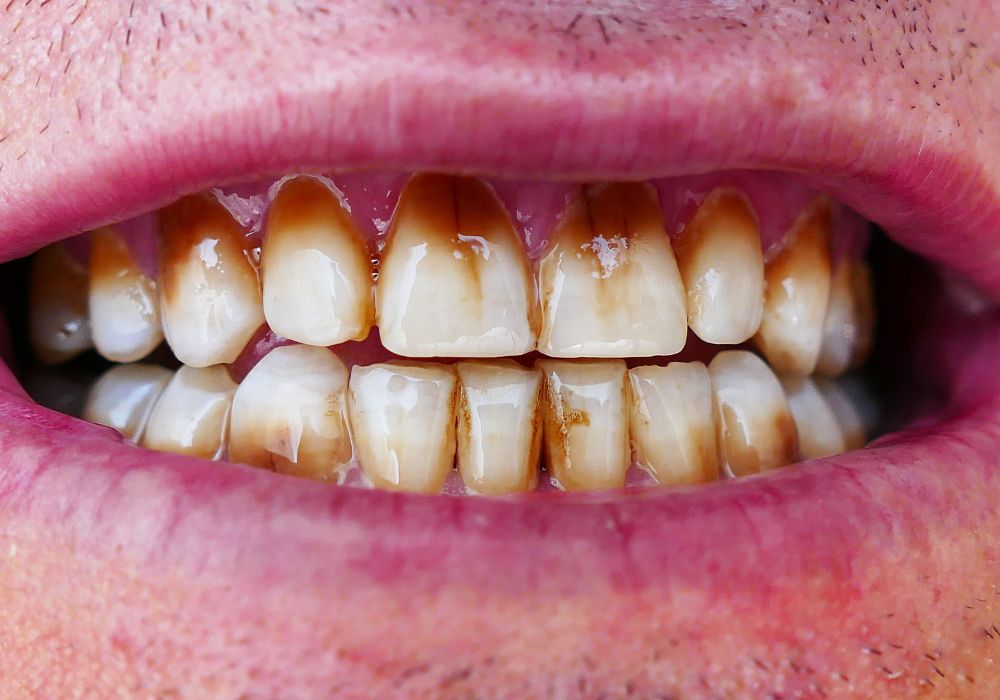
With the numerous ways smoking adversely affects oral health, it’s not surprising that smoking too much can lead to toothaches and dental pain. Here are some specific mechanisms by which smoking causes tooth pain:
Tooth decay
As smoking increases plaque buildup and tooth decay, it can result in cavities forming. Cavities damage the hard enamel covering of teeth and progressively eat away at the softer, sensitive dentin beneath. As the decay approaches the pulp chamber at the center of the tooth, pulpal inflammation and necrosis occurs.
This erosion into the dentin stimulates nerves within the tooth, causing toothache pain which can range from mild discomfort to severe, sharp, throbbing and intolerable pain depending on the extent and depth of the decay. Larger, deep cavities are more likely to reach the pulp and cause acute inflammation and infection manifesting as severe pain.
Receding gums
Periodontal disease from smoking causes the gums to detach from the teeth, forming periodontal pockets which harbor bacteria and become infected. Receding gums expose the tooth roots which are covered by thin, sensitive cementum rather than protective enamel.
Exposed roots can cause mild to severe, sharp pain from thermal, tactile, osmotic or chemical stimulation like hot, cold, sticky or acidic foods and drinks. Even gentle abrasion can stimulate pain. The larger the area of exposed root surface, the greater the pain sensitivity tends to be.
Dental abscess
With advanced gum disease, deep periodontal pockets containing pathogenic bacteria can develop around the tooth roots. Pus forming virulent bacteria like Porphyromonas gingivalis and Treponema species proliferate leading to a localized area of intense infection called a dental abscess.
Abscesses cause intense, pounding, unrelenting pain as pressure builds up under the tooth. The infection spreads to the surrounding periodontal ligaments and jawbone exacerbating inflammation and bone loss. This steady throbbing pain often radiates to the ear, temple, neck and sinus regions on the affected side.
Dry socket
Dry socket, which smoking makes more likely after extractions, involves severe, radiating pain affecting the tooth, jawbone, ear, temple and neck on the side of the affected socket. It develops when the blood clot at the extraction site is disrupted too early allowing the bone and nerves to be exposed to air, food and liquids.
Pain starts 3-5 days after extraction and can last a week or more with sharp throbs and spasms until the bare bone is protected again by forming granulation tissue. Heavy smoking within 48 hours after extraction increases risk up to 7 times.
Oral cancer
Oral cancer destroys healthy tissue in the mouth, causing painful ulcers, lesions and tumorous growths. It most often affects the tongue, floor of mouth, cheeks, gums, lips and palate. Oral cancer sites become extremely sensitive and painful, especially when irritated by chewing, swallowing food and liquids, alcohol or tobacco use.
As the cancer advances, it can invade and spread to surrounding areas like the pharynx, larynx, sinus and neck lymph nodes. This can cause referred pain in the jaw, ear, neck and upper shoulders. Intense, unrelenting pain typically indicates late stage progression.
How Much Smoking Can Cause Tooth Pain?
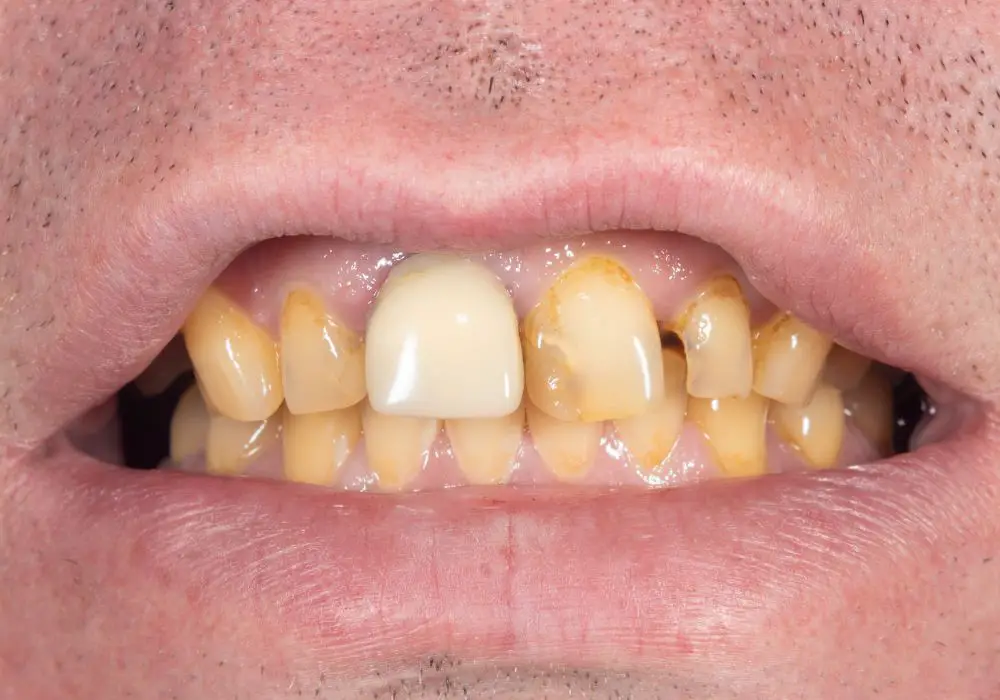
Tooth and mouth pain can result from both light and heavy smoking. However, the risk and severity of pain and dental issues increases proportionately with greater tobacco use in a dose-dependent manner. Some key associations between smoking amount and dental pain:
- Having 5 or more cigarettes daily doubles the risk of needing root canal treatment compared to nonsmokers.
- Smoking 10 or more cigarettes per day leads to significantly higher levels of plaque, tartar, tooth decay, receding gums, lost bone support, and advanced periodontal disease compared to nonsmoking.
- Smoking 20 cigarettes or more per day triples the risk of mouth cancer compared to never smokers. The relative risk rises rapidly for heavier smoking patterns.
- Those smoking more than 20 cigarettes daily have markedly higher rates of tooth loss, gum recession exceeding 3mm, and persistent dental pain from pulpal inflammation compared to lighter smokers and nonsmokers.
- Frequency of smoking also matters. Smokers who smoke their first cigarette within 30 minutes of waking have greater periodontal tissue destruction.
- Having a cigarette within 5 minutes after a tooth extraction dramatically increases the risk of developing dry socket – up to 7 times higher prevalence. Heavy smokers are affected most.
On the other hand, studies show cutting down tobacco usage by even 50% can significantly improve periodontal health, reducing gum bleeding, inflammation, tooth mobility and dental pain. Quitting smoking confers even more oral health benefits with gum and tooth problems declining close to nonsmoker levels after 5-10 years of total tobacco cessation.
Can Vaping Also Cause Dental Pain?
Vaping or using e-cigarettes has grown popular especially among youth due to perceptions that vaping is safer and more socially acceptable than smoking combustible cigarettes. But emerging research indicates vaping still exposes the mouth to nicotine, carcinogens and toxic irritants that impact oral health. Key associations include:
- Nicotine reduces saliva flow leading to xerostomia (dry mouth). Dry mouth significantly increases the risk of cavities and tooth decay which when severe can cause pain.
- A 2019 study found that exclusive e-cigarette users had significantly higher rates of dental caries and tooth loss compared to non-users. This indicates vaping increases decay risk.
- 15% of vapers in one survey reported gum tenderness, pain and swelling. Vaping irritates and inflames oral tissues.
- Vaping can potentially cause oral lichen planus – a condition where damaged skin cells lining the mouth trigger painful lesions.
Overall, vaping is generally considered less harmful than smoking with regard to oral health and dental pain. But more longitudinal studies are needed to clarify risks as vaping is a relatively new habit. For now, avoiding both vaping and smoking appears the wisest choice to minimize dental problems and pain.
Tips to Manage Smoking-Related Tooth Pain
Here are some tips to help prevent and manage toothaches and dental pain caused by smoking:
- Quit smoking and vaping altogether – this is the most effective way to avoid smoking-related oral health issues over the long run. Consult your doctor for smoking cessation help.
- Cut down gradually on cigarettes if going cold turkey seems too difficult initially. Try limiting first cigarette until afternoon.
- Use nicotine replacement therapy (gum, patches, inhalers) to help withdraw from smoking dependence. Taper off gradually.
- Drink plenty of water – at least 2 liters daily – to stimulate saliva flow and prevent dry mouth.
- Limit intake of sugary drinks and acidic juices which erode enamel and cause sensitivity.
- Use a fluoride toothpaste and antibacterial mouthwash twice daily to control plaque.
- Brush gently with soft bristles and avoid over-brushing which can abrade gum tissue.
- Floss daily to clear debris from between teeth. Be gentle around swollen gums.
- Have professional teeth cleanings every 6 months to remove staining and calculus deposits.
- Get dental abscesses treated promptly with root canal therapy or tooth extraction. Delay worsens infection.
- Take over-the-counter pain relievers like acetaminophen or ibuprofen to temporarily alleviate mild to moderate tooth pain per dosage instructions.
- Clove oil applied topically helps numb toothache pain. It contains eugenol having analgesic and antibacterial properties.
- See a dentist promptly if you have tooth pain lasting over 2 days or not responding to OTC painkillers. They can diagnose the cause and provide appropriate treatment.
When to See a Doctor?
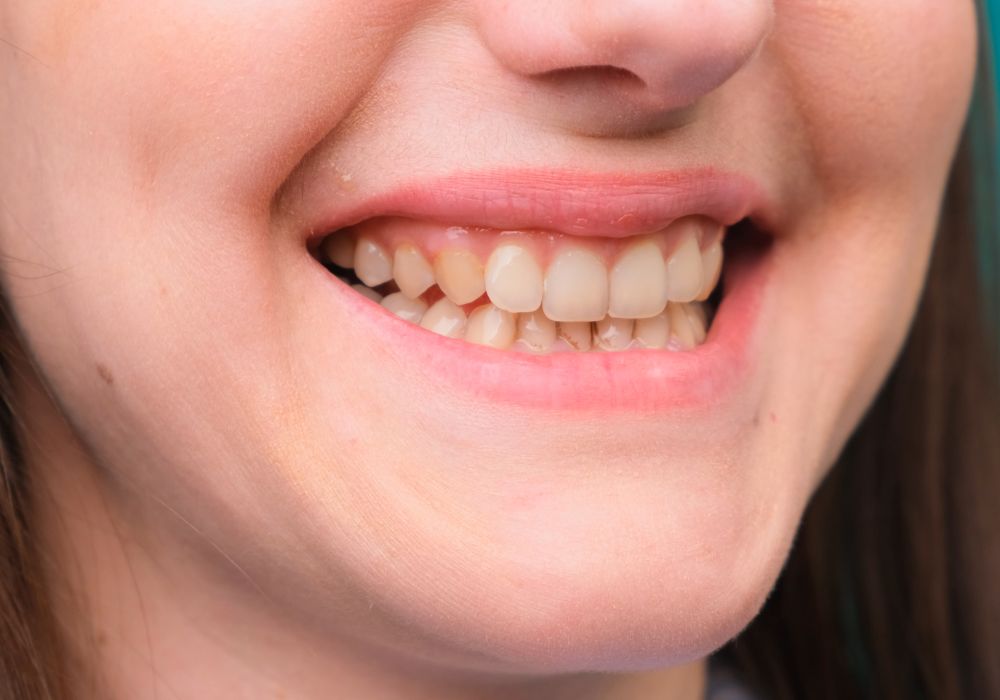
Consult a dentist right away if you experience any of the following warning signs of potentially serious dental issues:
- Severe toothache and/or jaw pain that keeps you awake at night.
- Tooth sensitivity or pain that persists for over 2 days without relief from OTC remedies.
- Prolonged temperature sensitivity – excessive response to hot or cold stimuli.
- Swelling in the gums, jaw, cheek or neck regions.
- Bleeding from the gums, especially when brushing or flossing.
- Sudden chipping, cracking, or change in color of a tooth.
- White/red patches, ulcerations, swellings or lumps in the mouth.
- Numbness, tightness or altered sensation in the teeth, gums or surrounding area.
- Difficulty or pain with chewing, swallowing, or opening the mouth fully.
- Bad breath or foul taste in the mouth persists despite oral hygiene.
- Loose teeth, or change in way teeth fit together when biting.
Such symptoms could indicate potentially serious problems like an abscess, infection, cracked tooth, dry socket, leukoplakia, oral cancer or other issues requiring urgent dental care and intervention. Don’t delay – the dentist will examine thoroughly, diagnose the problem and provide suitable treatment to resolve the tooth pain before it escalates.
Frequently Asked Questions
1. Does smoking cause teeth to loosen and fall out?
Yes, smoking is a leading risk factor for advanced periodontitis and tooth loss. By damaging tissues supporting the teeth like the periodontal ligament and bone, smoking causes teeth to loosen and eventually fall out if gum disease is left untreated. Quitting smoking helps stabilize periodontal damage.
2. Why do my teeth hurt when I smoke after not smoking for a while?
When you abstain from smoking for some time, your blood circulation and oxygenation improves. Gums become less inflamed and teeth less sensitive. Smoking again abruptly constricts blood vessels causing gum pain and pronounced temperature sensitivity that feels magnified after a period of smoking cessation.
3. Can vaping with nicotine-free e-juice still affect dental health?
Yes, even when vaping nicotine-free juice, the vapor contains chemicals like acrolein, formaldehyde and propylene glycol which irritate oral tissues. This aggravates tooth sensitivity and worsens gum recession, tooth decay and erosion. So vaping without nicotine still carries risks to dental health.
4. How long after quitting smoking does the risk of dental problems decrease?
Research shows the risk of oral health issues like gum disease and tooth loss drops rapidly in the first 5-10 years after quitting smoking as blood circulation and healing capabilities improve. Risk continues decreasing progressively the longer one abstains from tobacco use.
5. Why does smoking suppress pain from a cavity?
Nicotine stimulates the adrenal glands to release endorphins which act on pain receptors as temporary analgesics. But this only masks the pain of decay – tooth destruction continues unabated under the surface. This false analgesic effect prevents early diagnosis and causes more severe cavities.
Conclusion
In summary, smoking and tobacco use substantially increase the risk for various dental problems – from gum disease and cavities to oral cancer. Both light and heavy smoking can impact the mouth in ways that heighten vulnerability to sensitive, painful conditions like decay, receding gums, pulpitis and dry socket. But the frequency and severity of dental issues rises proportionately with increased tobacco consumption. Quitting smoking and maintaining diligent oral hygiene are the most effective ways to avoid many smoking-related dental pains. However, if you do experience persistent, severe or recurring toothaches and mouth pain, promptly consult a dentist to identify the cause before lasting damage occurs. With early diagnosis and intervention, most smoking-related dental problems can be treated and reversed.

